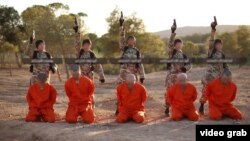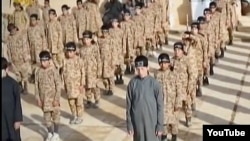The Islamic State (IS) propaganda machine, largely credited with helping the terror group recruit 30,000 foreign fighters, is posting online a fraction of the videos and images it was a year ago, and appears to be struggling to maintain production as it comes under growing pressure from foes on the battlefield, according to researchers.
A study released this week by the Combating Terrorism Center at the U.S. Military Academy at West Point, shows there has been a plunge during the past 12 months in IS' digital media production, declining from a peak of 761 releases a month in August of 2015, to just 194 a year later.
“It is clear the organization has been forced to cut back these activities in response to the increasing amount of counterterrorism pressure brought to bear,” conclude researchers.
They argue the decline is evidence that IS is finding it a challenge to devote the personnel and secure the resources to keep up production rates of propaganda that portrays the group as Muslim champions in an apocalyptic competition with non-Muslims that glories in executions of enemies.
Strikes effective
Most of the reduction in media output is likely a direct consequence of the anti-IS coalition’s offensive, which has shrunk dramatically the territory IS controls in Iraq and Syria. Its media production facilities are being destroyed and propagandists killed in airstrikes, say the West Point researchers.
Two of the terror group’s top propagandists have been killed in recent weeks. Abu Muhammad al-Adnani, who is thought to have personally selected execution videos, was killed in an airstrike in late August. In September, al-Adnani’s replacement as the group’s chief spokesman, Abu Muhammad Furqan, was killed in a targeted coalition airstrike on his home.
Furqan was suspected by U.S. officials of having overseen the production of the videos recording the beheadings of American and British journalists and aid workers, including James Foley. He was thought to have been the day-to-day manager of a team of mostly Western, media-savvy jihadists who produced videos, full-length documentaries, photo essays and audio clips marketing the caliphate and glamorizing barbaric violence.
State-making setbacks?
The researchers, who focused on media output from official IS media outlets, found the biggest reduction in the past 12 months has come in the videos and other propaganda marketing the virtues of the caliphate and presenting peaceful activities of a functioning jihadist state.
From its beginning, IS propagandists sought to craft an online narrative of state-making, say analysts, with videos depicting bustling commerce and orderly everyday life in Raqqa, its headquarters, and the Iraqi city of Mosul, sending a surreal message of normalcy in a bid to legitimize a state no country in the world recognizes.
The state-making narrative distinguished IS from other jihadist groups.
In one notable 2015 propaganda video, the group showed British photojournalist John Cantlie, who is being held hostage, touring Mosul in the role of a TV correspondent, disputing Western media reports that the city is “in a state of near collapse.
“The media likes to paint a picture of life in the Islamic State as depressed, people walking around as subjugated citizens in chains, beaten down by strict, totalitarian rule,” the group’s propagandists had Cantlie narrate.
The captive photojournalist declared, “Apart from some rather chilly, but very sunny December weather, life here in Mosul is business as usual” and enjoyed by “people from every walk of life.”
West Point researchers say the propaganda output of videos showing store shelves well-stocked, children swimming and playing, and farmers cultivating fields has dwindled to virtually nothing.
“This decline suggests that the group is struggling to maintain the outward appearance of a functioning state,” the study argues.
Militants resources dwindling
On Tuesday, U.S. State Department spokesman John Kirby welcomed the West Point report.
Using the Arab acronym for IS, he said, ”We have been making a dent in Daesh's ability to propagate their twisted narrative and recruit fighters, either to come to Iraq or Syria or to conduct attacks at home. We know they're having trouble recruiting talent and we know that they're having trouble retaining fighters and they certainly continue to lose leaders.”
In April, the Pentagon estimated the flow of foreign fighters entering Syria to enlist with IS had dropped from 2,000 a month to about 200 a month.
The Middle East Media Research Institute (MEMRI), a Washington-based organization that monitors jihadists’ activity on the Web, reported in April that since late 2015, there has been a noticeable drop in the presence online of IS members based in Syria and Iraq.
“IS members were more visible and vocal across a plethora of social media platforms than they are today,” MEMRI’s study concluded. It added that now supporters overseas “are most crucial in disseminating the group's message.”
Anat Agron, a research fellow at MEMRI, told VOA in April that this has been particularly the case for female IS members. They had been at the forefront of the terror group’s effort to wage psychological warfare, lure Western women to the marriage beds of IS “holy warriors” and market the group online, posting personal photos on social media accounts and offering a stylized glimpse of life in the caliphate.
Meanwhile, researchers at West Point say the posting of IS videos showing executions of alleged spies have jumped significantly, suggesting IS is becoming more fearful of infiltrators and deserters.










